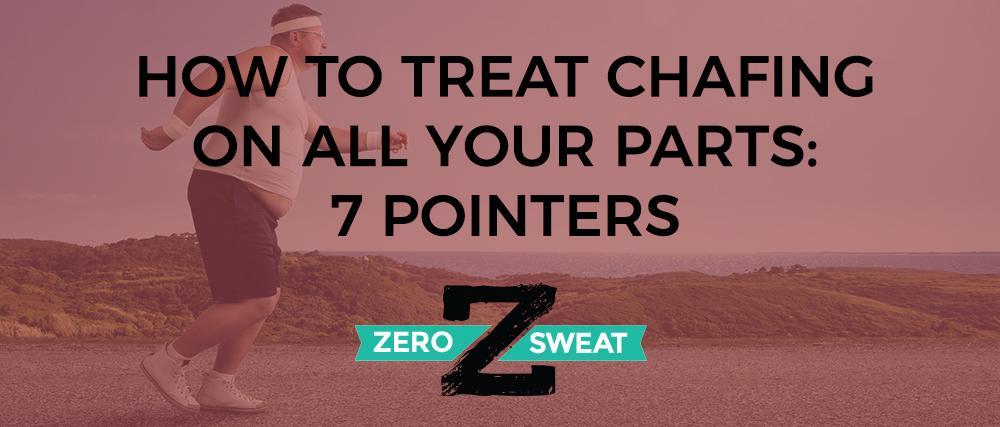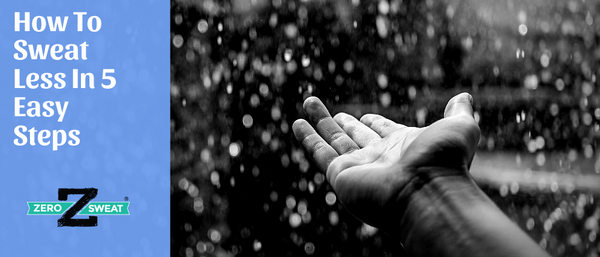How To Treat Chafing On All Your Parts: 7 Pointers

As the temperature rises and your body begins to perspire—often in some surprising places—you may find yourself desperate for a chafing remedy. If you want to know how to treat chafing in your sensitive areas, then read on.
Before we dive into what you can do to prevent chafing (also known as chub-rub), it’s important to understand why it happens. When moist skin rubs against other moist skin, your skin can become irritated, producing a painful rash. This occurs because friction creates microscopic abrasions on the skin. The salt in your sweat only causes the irritation to worsen, and if left untreated, could compound into a full-blown infection.
To avoid the pain and irritation associated with chafing, there are a few pointers to prevent and treat chafing at the source:
1. USE A CLINICAL-STRENGTH ANTIPERSPIRANT

By using an antiperspirant, like ZeroSweat’s roll-on, you prevent the number one culprit to chafing: sweat. While this may seem like an obvious choice to prevent underarm chafing, it can be applied to any of your sweaty unmentionable parts, including under breasts or inner thighs! For underarms and most other areas, the roll-on works wonders, but for sensitive areas, ZeroSweat lotion might be a better option. Just administer a thin layer to the desired area and let it dry completely.
By taking a stand against sweat before it becomes a problem, you not only prevent the salt in your sweat from irritating your skin but you also create a barrier of lubrication that reduces friction.
2. CREATE A BARRIER TO REDUCE FRICTION.
Deodorants and antiperspirants aren’t the only topical products you can apply to create a protective barrier for your skin. There are other products out there that can be more widely used over the entire body, such as Gold Bond Friction Defense, Body Glide, or regular petroleum jelly. Look for products with ingredients like wax, polyethylene, silica, and zinc oxide. These ingredients keep your skin lubricated without feeling sticky (yuck!).
3. WEAR THE RIGHT CLOTHES.

Stretchy, form-fitting clothing that stays close to the body is best to avoid chafing while exercising. Loose-fitting clothes made of materials like cotton may be your worst enemy when you are prone to chafing. Instead of wicking sweat, cotton simply traps moisture, which may cause further skin irritation.
Instead, reach for clothes made of materials that wick moisture, such as polyester or Lycra (shown above). This will keep your skin dry, thereby preventing the moisture and abrasion that causes chafing
4. CONSIDER CHAFING BANDS.
Many of us have been there: It’s a hot day, and while the dress you are wearing may help keep you cooler, the sweat on your thighs is causing some discomfort as you walk about. Although topical anti-chafe products may help with this common problem, sometimes your sweat may become overpowering.
If topical anti-chafe products do not work for your thighs, it may be time to purchase some anti-chafing bands. Anti-chafing bands are two cloth bands worn on the upper-thigh (often with skirts and dresses) that provide a grease-free and chemical-free solution to chafing so you can enjoy some peace of mind as you enjoy your active day.
5. APPLY NIPPLE GUARDS.
To avoid suffering the excruciating pain and embarrassment of bloody shirts and raw nipples, many long-distance runners apply them before big races for protection. Nipple guards like Nip Strips are fairly common and a critical solution to prevent nipple chafing.
If you’ve ever experienced nipple chafing after an extended workout, where your body’s dried sweat feels like sandpaper between your skin and your shirt, nipple guards are a quirky quick-fix. Simply apply the medical adhesive to the base of the nipple before your workout and experience comfort during even the most intense of tests of human endurance.
6. FIND A WAY TO STAY DRY.
Another easy way to prevent chafing through topical application is to select products meant to keep you dry. While antiperspirants work well for the underarm, products like cornstarch can help keep your skin dry before activity. As an added bonus, these products may already be lying around the house, making it a quick, cheap, DIY solution.
There are some brands formulated for sports, including Squeaky Cheeks, but be sure to select an unscented product lest you want to experience further skin irritation from the perfume.
7. STAY HYDRATED.
As is the case with most excessive sweating, one of the best things you can do to stay dry and sweat healthy is to drink lots of water. Staying hydrated before, during, and after your workouts will you to perspire without your sweat turning into salt crystals, preventing the salt to abrade the skin and produce a rash or other irritation.
Chafing is an uncomfortable reality for many of us, but that doesn’t mean there aren’t steps you can take to prevent skin irritation. From antiperspirant products like ZeroSweat to picking the clothing that uses the right materials, there are lots of things you can do to prevent chafing before it happens. Let us know how these tips work for you!



